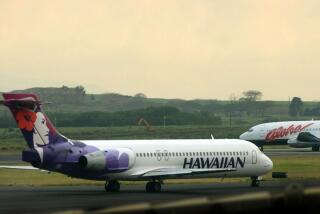UAL Exec Confident of US Airways Merger
- Share via
United Airlines’ parent, UAL Corp., is confident it can overcome regulatory, labor and congressional opposition and complete its controversial $4.3-billion buyout of rival US Airways Group Inc., UAL’s president said Thursday.
And although United already is the biggest U.S. airline, UAL is pursuing the deal mainly to establish a broader national presence that will enable travelers to fly more nonstop routes between major cities, which is what passengers are demanding, said Rono Dutta, who is also United’s president.
“We’re doing this because the customer needs it,” Dutta said at a meeting with reporters, noting that no U.S. carrier has “a complete” national network of service. “When the customer needs it, you have to respond.”
United has major hubs in Chicago, Denver, San Francisco and Los Angeles, but it is relatively weak in the East except for a small hub at Washington’s Dulles airport. US Airways, though, has a big presence in the East. US Airways also would provide United with additional cities that would serve as springboards for more international travel.
The deal, though, has unleashed a chorus of controversy. Some members of Congress, travelers’ advocates and industry analysts fear that the UAL-US Airways deal could spark a wave of mergers among the handful of other major U.S. airlines that would reduce competition, weaken service and hike fares.
Even United’s own pilots oppose the merger. Their union, the Air Line Pilots Assn. (ALPA), contends that the airline hasn’t yet done enough to assure its members that they’ll have job security following the deal.
Dutta said the merger can be completed after it is approved by US Airways’ stockholders and Justice Department regulators. And he discounted the prospect that regulators would block the merger because it might prompt other big airlines to seek merger partners.
“Could this lead to other mergers? Absolutely,” Dutta said. But “the Department of Justice looks at each deal on a stand-alone basis,” and UAL believes its pact with US Airways has little overlap and thus will meet the agency’s standards for sustaining competition, he said.
As for labor, “the merger probably could and would close” even if the pilot groups for both carriers are at odds over how to integrate their members in terms of seniority, which is always a sticky issue in airline mergers, Dutta said. The “primary negotiations” have to be between the two pilot groups, he added.
But Kathie White, a spokeswoman for the ALPA council that represents United’s pilots, noted that the council voted two weeks ago to oppose the deal until it sees what “improvements the company is prepared to offer to ensure that the United pilots are treated appropriately” after the merger.
Both airlines’ pilots are represented by ALPA, whose rules call for them to negotiate seniority and other issues after a merger is completed. But lingering disputes between the pilot groups could get the newly merged airline off to a slow start if they lead to low morale, poor service or even flight disruptions.
Indeed, one problem area is that US Airways--which is an amalgam of several airlines merged over the years--has many pilots with years of seniority. That could cause friction with younger pilots at United as both groups vie for the job of captain and other senior pilot posts at the merged airline.
“We do have a senior pilot group . . . and we expect that to be recognized” in the negotiations, said Roy Freunglich, a spokesman for the US Airways’ ALPA council.
More to Read
Inside the business of entertainment
The Wide Shot brings you news, analysis and insights on everything from streaming wars to production — and what it all means for the future.
You may occasionally receive promotional content from the Los Angeles Times.











